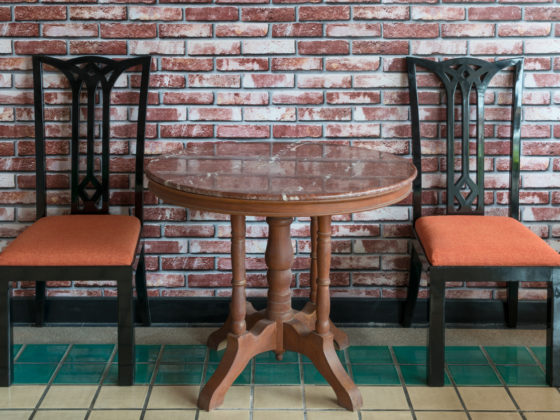
Some antiques come into our homes, find their spots, and remain purely decorative. Others become workhorses: the dining room tables, end tables, coffee tables, and sofa tables. These pieces refuse to be ignored and ask to be used daily. So how should you protect your new-to-you antique tables from the slings and arrows of daily life?
Basic Steps
We will assume you want to keep some of the existing finish on your table. In that case you look to clean it up a little bit and then maintain it. So here are a few basic steps:
- Dry Cleaning – No, not with garment bags and chemicals. Your first try should always be with a soft cloth and gentle pressure.
- Mild Detergent – If a deeper cleaning is needed, mild detergent and lukewarm water can be used with a soft cloth. Don’t use any wet cleaning agents if your table is unfinished wood, though!
- Wax – When it’s completely dry, rub on a quality paste wax (beeswax based and definitely not spray) to add protection and a beautiful sheen. Follow the directions on the can to buff it and repeat at least yearly. We like Bruce wax but be very careful not to get it on anything else as it does a great job of adding stain that won’t budge. That can be wonderful for depth of color on your table but not great for your wallpaper.
Should I Refinish My Table?
Short answer: No, it’s an antique and should retain its original finish.
Longer answer: It depends. Okay, that is actually a shorter answer, but a true one. Should you be the lucky owner of a mahogany Chippendale writing table or a Gustav Stickley library table, then no, definitely not.
If, instead, it’s a beautiful but fairly common quarter sawn oak table with benign neglect over the years, then it’s up to you. Refinishing can be done in degrees. It can range from making a table look like new again to just refinishing it and embracing some of its nicks and dings as part of its character.
What about Water Rings or Heat Marks?
Telltale white rings or marks on pieces with a varnish or shellac finish (much of the 18th and 19th century) may require professional help to remove. For newer or merely oiled finishes, you first shake your fist at the perpetrator and throw a coaster at them. Then you need to gently rub the surface where the ring is to allow the trapped condensation to escape. One method is to use a soft, damp cloth with a little baking soda. Another trick is to mix the super soft ash from your fireplace with a little bit of mayonnaise in a dixie cup. Take that mixture and apply it on top of the new water ring and let it sit for an hour. The ash draws out the water and the mayo moisturizes the wood. Either way, clean the surface after the treatment and wax to protect it again.
Should I Stop Using My Tables?
As we said earlier, unless you have a masterpiece of craftsmanship, enjoy and use your favorite antique furniture. Placemats, coaster, and trivets can help prevent damage to table surfaces. Occasional waxing throughout the year will help keep them in good shape. Consider adding a removable table pad or tempered glass top. Especially if you feel your table needs a little extra protection from food, drinks, craft projects and the ever present water bottle.
One of the things we love about antiques is the stories they carry. Using antiques in your home allows them to be part of your family’s memories, too. Care for them well and they’ll live far into the future.

